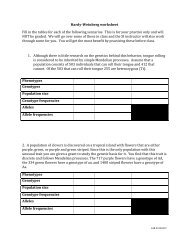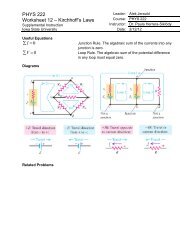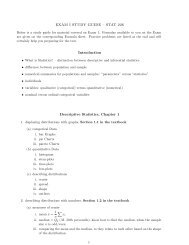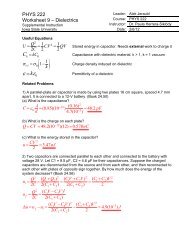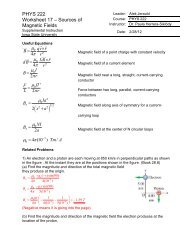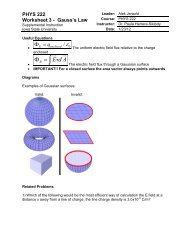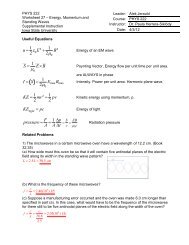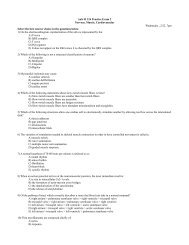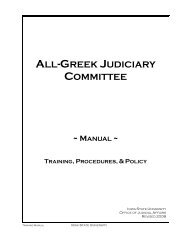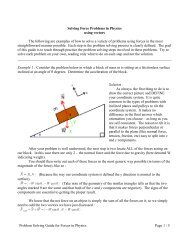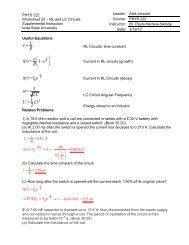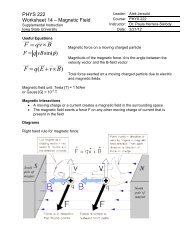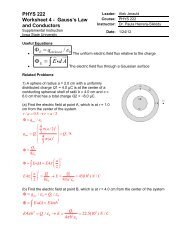Create successful ePaper yourself
Turn your PDF publications into a flip-book with our unique Google optimized e-Paper software.
Supplemental Instruction<br />
Finance 301: Porter<br />
Chapters 6-8<br />
Exam 3<br />
Chapter Six: <strong>Interest</strong> <strong>Rates</strong><br />
1. What are the four most fundamental factors affecting the cost of money?<br />
Production opportunities- the investment opportunities in productive<br />
(cash generating) assets<br />
Time preferences for consumption- the preferences of consumers for<br />
current consumption as opposed to saving for future consumption.<br />
Risk- the chance that an investment will produce a lower than expected,<br />
or negative return.<br />
Inflation- the amount by which prices increase over time.<br />
2. What is the price paid to borrow debt capital called?<br />
a. The interest rate<br />
b. The risk premium<br />
c. Capital gains<br />
d. Dividends<br />
3. What are the two items whose sum is the cost of equity?<br />
a. The interest rate and the default risk premium<br />
b. The interest rate and the maturity risk premium<br />
c. Dividends and capital gains<br />
d. None of the above<br />
4. What is formula for the quoted interest rate?<br />
r= r* + IP + DRP + LP + MRP<br />
r= the nominal, quoted rate of interest on a given security<br />
r*= risk free rate<br />
IP= inflation premium<br />
DRP= default risk premium<br />
LP= liquidity premium<br />
MRP= maturity risk premium
5. What is interest rate risk?<br />
The risk of capital losses to which investors are exposed because of<br />
changing interest rates. This is reflected in the maturity risk premium.<br />
6. What is reinvestment rate risk?<br />
The risk that a decline in interest rates will lead to lower income when<br />
bonds mature and funds are reinvested. Short term investments are<br />
exposed to this.<br />
7. The term structure of interest rates is the relationship between __________<br />
and __________.<br />
a. <strong>Interest</strong> rates and interest premiums<br />
b. Bond yields and maturities<br />
c. Bond prices and coupon payments<br />
d. <strong>Interest</strong> rates and maturities<br />
8. What is the graph that represents the relationship between bond yields<br />
and maturities?<br />
a. The maturity curve<br />
b. The bond curve<br />
c. The yield curve<br />
d. The yield wave<br />
interest rate %<br />
normal<br />
humped<br />
abnormal<br />
Years to maturity<br />
Study the determinants that shape the yield curve on pages 189-192
9. What does the pure expectations theory state?<br />
A theory that states that the shape of the yield curve depends on<br />
investors’ expectations about future interest rates. It ignores maturity<br />
risk premium<br />
10. Name four other factors that can influence interest rates as discussed in<br />
your text?<br />
Federal reserve policy, federal budget deficit or surpluses, international<br />
factors, and business activity.<br />
11. When investing overseas, what are two additional types of risk that<br />
investors have to worry about?<br />
a. yen risk and euro risk<br />
b. default risk and inflation premium<br />
c. liquidity premium and euro risk<br />
d. country risk and exchange rate risk<br />
12. 30 day T Bills are currently yielding 6%. The inflation premium is 2.5%,<br />
the liquidity premium is 0.8%, maturity risk premium is 1.5% and the<br />
default risk premium is 2.7%. What is the real risk free rate of return?<br />
r=r* + IP + DRP + LP + MRP<br />
6= r* + 2.5<br />
3.5= r*<br />
13. The real risk free fate is 3%. Inflation is expected to be 1% this year and<br />
3.5% in the next 3 years. Assume that the maturity risk premium is 0%.<br />
What s the yield on 2 year treasury securities? How about 4 year<br />
treasury securities?<br />
r TBill 2yr<br />
= r* + IP + MRP<br />
r TBill 4yr<br />
= r* + IP + MRP<br />
= 3 + (1 + 3.5)/2 = 3 + (1 + 3.5 + 3.5 + 3.5)/4<br />
3 + 2.25= 5.25 3+ 2.875= 5.875
14. A treasury bond that matures in 10 years has a yield of 5.5%. A 10 year<br />
corporate bond has a yield of 7.5%. Assume that the liquidity premium<br />
on the corporate bond is 0.6%. What is the default risk premium on the<br />
corporate bond?<br />
r corp<br />
= 7.5= r* + IP + MRP + LP + DRP<br />
r tbill<br />
= 5.5= r* + IP + MRP<br />
since they are both 10 year securities, the IP and MRP are the same for<br />
both so<br />
r corp<br />
=7.5= 5.5 + LP + DRP<br />
= 7.5 = 5.5 +0.6 + DRP<br />
-6.1 -6.1<br />
1.4= DRP<br />
15. <strong>Interest</strong> rates on 4 year Treasury securities are currently 8%, while six<br />
year Treasury securities are yielding 8.5%. If the pure expectations<br />
theory is correct, what does the market believe 2 year securities will be<br />
yielding 4 years from now?<br />
(1 + 6yr rate) 6 = (1 + 4 yr rate) 4 (1+ 2 yr rate) 2<br />
(1.085) 6 = (1.08) 4 (1 + x) 2<br />
Then just solve for x<br />
Chapter 7: Bonds and Their Valuation<br />
16. What is a bond?<br />
a. A long term debt instrument under which a borrower agrees to<br />
make payments of interests and principal on specific dates to the<br />
holders of the bond.<br />
17. What are the four main types of bonds?<br />
a. Treasury bonds- issued by federal government<br />
b. Corporate bonds- issued by corporations<br />
c. Municipal bonds- issued by state and local governments<br />
d. Foreign bonds- issued by foreign governments and foreign<br />
corporations. Holders of these bonds also have to worry about<br />
currency value relative to dollar. Ex: will lose $ if yen falls<br />
relative to dollar.<br />
18. What is par value?<br />
a. The stated annual interest rate on a bond
. The number of dollars of interest paid each year<br />
c. The face value of a bond<br />
d. The coupon<br />
19. What is the maturity date?<br />
a. The date that coupon payments must be made each period.<br />
b. The date that the bond may be called<br />
c. The date in which interest must be paid<br />
d. The date on which the par value of the bond must be repaid.<br />
20. What is a call provision, and what does a call provision usually include?<br />
a. A call provision is a statement within the bond contract that vies<br />
the issuer the right to redeem the bonds under certain terms prior<br />
to the original maturity date.<br />
i. A call premium is usually included which is extra<br />
compensation for the investor. This is usually set equal to<br />
one year’s interest.<br />
ii. Call protection prevents the issuer from being able to call the<br />
bond for a certain number of years. Usually 5 to 10 years.<br />
21. What would entice an issuer to call bonds early?<br />
a. If they issued bonds at relatively low rates and then rates rose so<br />
they could reissue at higher rates.<br />
b. If they issued bonds at relatively high rates and then rates fell so<br />
they could reissue at lower rates.<br />
This would allow them to use the proceeds of the new issue to retire<br />
the high issue and then reduce their interest expense. So calling is<br />
good for the issuer, bad for the investor.<br />
22. What is a sinking funds provision?<br />
a. A provision that allows the issuer to call bonds early.<br />
b. A provision that allows the issuer to extend the life of the bond<br />
c. A provision that requires the issuer to retire a portion of the bond<br />
issue each year.<br />
i. The issuer has to buy back a specified % of the bonds each<br />
year.
ii. If they do not do this, it is considered default which may send<br />
them into bankruptcy.<br />
23. A floating rate bond is a bond who’s interest rate fluctuates with<br />
______________________ while an indexed bond has interest payments based<br />
on an ____________________.<br />
a. Shifts in the general level of interest rates, inflation index<br />
b. Inflation premiums, interest rate index<br />
c. U.S. T-bill rates, interest rate index<br />
d. The real risk free, inflation premium<br />
24. What is a discount bond?<br />
a. A bond that sells above par value; occurs whenever the going rate<br />
of interest is above the coupon rate.<br />
b. A bond that sells at par value.<br />
c. A bond that sells below par value; occurs whenever the going rate<br />
of interest is above the coupon rate.<br />
d. A bond that sells below par value; occurs whenever the going rate<br />
of interest is below the coupon rate.<br />
also explain premium: bond that sells above par: happens when<br />
going rate of interest is below the coupon rate.<br />
25. What is yield to maturity?<br />
a. The rate of return earned on a bond if it is called before the<br />
maturity date.<br />
b. The rate of return earned on a bond if the issuer extends the life of<br />
the bond past the original maturity date.<br />
c. The rate of return earned on U.S. T-bill.<br />
d. The rate of return eared on a bond held to maturity.<br />
Also explain yield to call: rate earned if called before maturity<br />
date.<br />
26. What is interest rate risk?<br />
a. The risk of a decline in a bond’s price due to an increase in interest<br />
rates. When this happens, the price falls, which causes a risk to<br />
bond holders b/c their investments are then worth less. Higher
with longer maturities because the longer the maturity, the longer<br />
before it is paid off and can be replaced for one with a higher<br />
coupon.<br />
27. What are investment grade bonds?<br />
a. Bonds rated A or higher.<br />
b. Bonds rated from B to A<br />
c. Bonds rated BBB or higher<br />
d. Bonds rate B or lower<br />
Look at the bond rating criteria on pg 229-230<br />
28. Does a firm prefer chapter 7 or chapter 11 bankruptcy, and why?<br />
a. Chapter 7 because they can make $ by selling their assets.<br />
b. Chapter 11 because it buys them time to reorganize their company.<br />
29. Porter Enterprises’ bonds have 8 years remaining to maturity. <strong>Interest</strong><br />
is paid annually, and they have $1000 par value; the coupon interest rate<br />
is 8%; and the yield to maturity is 9%. What is the current market price?<br />
N= 8 I/Y=9 PMT= 80 FV= 1000 CPT PV<br />
30. A bond has a $1000 par value, 10 years to maturity, a 7% annual coupon<br />
and sells for $985.<br />
a. What is its current yield?<br />
Annual interest payment/ current price<br />
= 70/985<br />
= 7%<br />
b. What is its yield to maturity?<br />
N= 10 PMT= 70 PV= -985 FV= 1000<br />
CPT I/Y=<br />
c. Assume that the yield to maturity remains constant for the next 3<br />
years, what will the price be 3 years from today?<br />
N=7 PMT=70 FV= 1000 I/Y= (from#b) CPT PV<br />
31. Six years ago a company issued 20 year bonds with a 14% annual coupon<br />
rate at their $1000 par value. The bonds had a 9% call premium, with 5<br />
years of call protection. They were called today. Compute the realized
ate of return for an investor who purchased the bonds when they were<br />
issued and held them until they were called. Should the investor be<br />
or about this?<br />
N= 6 PV= -1000 FV= 1090 PMT=140 CPT I/Y= 15.03%<br />
The investor will probably not be happy about this because it indicates<br />
that interest rates have fallen significantly and that the current YTM<br />
will be lower than this YTC, so they will have to reinvest at much lower<br />
rates that they originally got.<br />
32. A 6% semiannual coupon bond matures in 4 years. The bond has a face<br />
value of $1000, and a current yield of 8.21%. What is the price and the<br />
YTM?<br />
N= 4*2= 8 YTM<br />
PMT= 60/2= 30<br />
N= 8 PMT= 30 PV= -730.82 FV= 1000 CPT I/Y<br />
FV= 1000 YTM= I/y * 2<br />
Cannot solve for I/Y without PV.<br />
Find PV by using CY= 8.21<br />
0.0821= annual interest pmt/price<br />
0.0821= 60/x<br />
0.0821x= 60<br />
Price= $730.82<br />
Chapter 8: Risk and <strong>Rates</strong> of Return only through slide 48<br />
33. Define Standalone risk<br />
a. The risk an investor would face if he/she held a well diversified<br />
portfolio of assets.<br />
b. The risk an investor would face if he/she only held 3 assets that<br />
were not well diversified.<br />
c. The risk an investor would face if he/she only held 1 asset.<br />
d. The risk an investor would face if he/she held two assets that were<br />
negatively correlated with each other.<br />
34. A ___________ ____________ is a listing of all possible outcomes or events<br />
with a chance of occurrence assigned to each outcome.<br />
a. Likelihood distribution<br />
b. Probability set<br />
c. Outcome results<br />
d. Probability distribution
35. If you multiply each possible outcome by its probability of occurrence,<br />
and then sum these products, we get a weighted average which is known<br />
as the _________ ________ ____ __________ or “r-hat.”<br />
a. Expected rate of return<br />
b. Realized rate of return<br />
c. Actual rate of return<br />
d. Eventual rate of return<br />
36. The _________the probability distribution of expected future returns, the<br />
_________ the risk of a given investment.<br />
a. Wider, greater<br />
b. Wider, smaller<br />
c. Tighter, greater<br />
d. Tighter, smaller<br />
37.<br />
WallyShop<br />
Tarjay<br />
a. Which of the above companies is least risky?<br />
i. Wally Shop b/c there is a smaller chance that its actual<br />
return will end up far below its expected return. (see pg 251)<br />
38. The ____________ the standard deviation, the tighter the probability<br />
distribution, and in turn, the __________ the riskiness of the stock.<br />
a. smaller, less (see pg. 251)<br />
b. Larger, larger<br />
c. Larger, smaller<br />
d. Tighter, larger<br />
39. What is the formula for finding standard deviation?<br />
^<br />
a. σ= √∑(r i<br />
-r) 2 Pi
. standard deviation is a weighted average of the deviations from<br />
the expected value gives an idea of how far above or below the<br />
expected return the actual return is likely to be.<br />
40. The ___________ __ ___________is the standardized measure of the risk per<br />
unit of return; it is calculated as the ___________ __________ divided by the<br />
____________ _________.<br />
a. Coefficient of variation, expected return, standard deviation<br />
b. Coefficient of variation, expected return, realized return<br />
c. Coefficient of variation, standard deviation, expected return<br />
d. Coefficient of variation, standard deviation, realized return<br />
41. Risk averse investors ___________ risk and require _________ rates of return<br />
as an inducement to buy riskier securities.<br />
a. Like, lower<br />
b. Dislike, lower<br />
c. Dislike, tiny<br />
d. Dislike, higher<br />
42. What is expected return on a portfolio, and how do you calculate it?<br />
a. It is the weighted average of the expected returns on the assets held<br />
in a portfolio.<br />
b. ^ ^<br />
r port<br />
= ∑w i<br />
r i<br />
43. ________ risk can be eliminated through proper diversification while<br />
_______ risk cannot be eliminated through diversification.<br />
a. Market, actual<br />
b. Diversifiable, actual<br />
c. Market, interest rate<br />
d. Diversifiable, market<br />
44. What is the CAPM? What is the beta, and how do you find portfolio<br />
beta?<br />
a. A model based on the idea that any stock’s required rate of return<br />
is equal to the risk free rate or return plus a risk premium that<br />
reflects the remaining risk after diversification. (relevant risk)<br />
b. Beta is a metric that shows the extent to which a given stock’s<br />
returns move up and down with the stock market. Beta measures<br />
market risk.<br />
i. You find portfolio beta by taking a weighted average<br />
ii. ∑w i<br />
b i<br />
45. Memorize the chart on page 271!<br />
46. What is the market risk premium?<br />
a. The additional return over the risk free rate needed to compensate<br />
investors for assuming average amounts of risk<br />
b. RP M<br />
= (r m<br />
-r RF<br />
)
i. r m<br />
= required rate or return on portfolio of all stocks (market<br />
portfolio). Also the required rate of return on average stock<br />
with beta of 1.<br />
47. What is the security market line equation?<br />
a. An equation that shows the relationship between risk as measured<br />
by beta and the required rates of return on individual securities.<br />
Required return on stock i= risk free rate + market risk premium * stock I’s beta<br />
48. A stock’s returns have the following distribution<br />
Demand for Product Probability Rate of Return w/<br />
demand<br />
Weak 0.2 (45)<br />
Below Average 0.1 (15)<br />
Average 0.45 15<br />
Above Average 0.1 25<br />
Strong 0.15 70<br />
=1<br />
What is the expected return? The standard deviation? The coefficient of<br />
variation?<br />
^<br />
Expected Return: r= ∑probability(return)<br />
= (0.2)(-45) + (0.1)(-15) + (0.45)(15) + (0.1)(25) + (0.15)(70)<br />
^<br />
Standard Deviation: σ= √∑(r i<br />
-r) 2 Pi<br />
= √∑(-45 – expected return)(0.2) + (-15-expected return)(0.1) + (15-expected<br />
return)(0.45) + (25-expected return)(0.1) + (70-expected return) (0.15)<br />
Coefficient of Variation: standard deviation/ expected return<br />
49. A stock has a required rate of return of 15%, the risk free rate is 8%, and<br />
the market risk premium is 4%. What is the stock’s beta?<br />
Required return on stock i= risk free rate + market risk premium * stock I’s beta<br />
15= 8 + 4(x)<br />
-8 -8
7/4= 4x/4<br />
1.75= beta<br />
50. Suppose you are the manager of the following portfolio that has $5<br />
million dollars invested in it. The portfolio consists of 4 stocks with the<br />
following investments and betas.<br />
Stock Investment Beta<br />
1 $500,000 1.25<br />
2 $75,000 -0.60<br />
3 1,425,000 1.50<br />
4 3,000,000 0.95<br />
If the markets required rate of return is 14%, the risk free rate is 6%,<br />
what is the portfolio’s required rate of return?<br />
500,000/5,000,000 (1.25) + 75,000/5,000,000(-0.60) +<br />
1,425,000/5,000,000 (1.5) + 3,000,000/5,000,000(0.95)<br />
= portfolio beta<br />
r= 6 + (14-6)(portfolio beta)<br />
answer= required rate of return.




